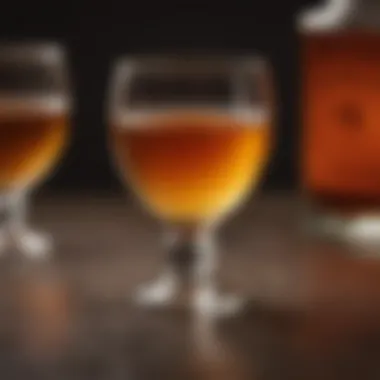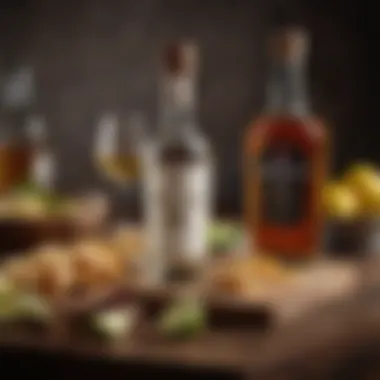The Essence of Maestro Tequilero Añejo Clásico


Intro
Aged spirits have their own unique allure, and Maestro Tequilero Añejo Clásico stands out among them. This tequila has gained recognition for its rich flavor profiles and time-honored production methods. It’s not just a beverage; it represents tradition and passion that goes into crafting each bottle. The understanding of its characteristics, historical context, and its role in today's drinking culture is essential for anyone looking to appreciate fine spirits.
Tequila, particularly the añejo variety, offers complexity that often captivates both casual drinkers and seasoned connoisseurs. The emphasis on carefully sourced ingredients, meticulous fermentation, and aging techniques contribute significantly to the final product's quality. The exploration of these elements reveals a narrative steeped in heritage while simultaneously embracing contemporary trends.
This article aims to dissect various aspects of Maestro Tequilero Añejo Clásico. From its craftsmanship to potential pairings, the narrative will ensure a greater appreciation for this distinguished spirit. Dive into the nuances of its flavor notes, the history intertwined with its production process, and discover suggestions for serving and enjoying this exquisite tequila.
"In every bottle of tequila, there is a story of the land, the people, and the craft that created it."
With so much to uncover, the journey into Maestro Tequilero Añejo Clásico promises to be enlightening and rewarding.
Prelims to Añejo Tequila
Añejo tequila holds a significant position in the world of spirits, often viewed as the pinnacle of tequila craftsmanship. It is essential to explore this segment as it showcases the sophistication and depth of flavor that comes from aging. Añejo, meaning "aged" in Spanish, refers to tequila that has been matured for a minimum of one year in oak barrels. This aging process imparts complex characteristics that set it apart from its younger counterparts like blanco or reposado tequilas.
Understanding Añejo tequila informs consumers about its unique attributes. It exemplifies traditional techniques and cultural heritage linked with tequila production in Mexico. Recognition of the intricacies involved helps appreciate the meticulous care put into every bottle of Maestro Tequilero Añejo Clásico.
Defining Añejo
Añejo tequila is defined by its aging process. According to Mexican law, for tequila to be labeled as Añejo, it must spend between one to three years in barrels. The barrels are typically made from American or French oak, enhancing the flavors and complexities of the spirit. This aging duration develops a smoothness and richness that is often sought after by both enthusiasts and casual drinkers.
Some key characteristics of Añejo tequila include:
- Color: Typically darker, ranging from amber to rich gold, derived from the wood of the aging barrels.
- Aroma: Complex and layered, with notes of caramel, vanilla, and sometimes spices.
- Taste: A balance of sweetness from the agave and the influence of wood, often complemented by hints of chocolate or dried fruit.
The Evolution of Tequila
The evolution of tequila is a fascinating journey that reflects Mexican culture and traditions. Tequila’s origins date back to the 16th century when Spanish colonizers began distilling agave to create a potent spirit. Over time, advancements in production methods refined the quality and flavor of tequila.
The distinction between different types, such as blanco, reposado, and añejo, emerged as producers experimented with aging techniques and barrel types. This development significantly contributed to the diversity in flavor profiles available today.
In recent years, the global popularity of tequila has soared. Añejo tequila, in particular, has gained recognition as a premium spirit, often compared with fine whiskies and rums. Many consumers are now seeking high-quality añejo brands, leading to a renaissance in artisanal production methods, especially those emphasizing tradition and craftsmanship.
Understanding these historical and cultural contexts enhances the appreciation of Maestro Tequilero Añejo Clásico, positioning it within a broader narrative of evolution in the spirits industry.
Understanding Maestro Tequilero
Understanding Maestro Tequilero is essential in grasping the overall significance and quality of Maestro Tequilero Añejo Clásico. The brand stands as a symbol of craftsmanship and dedication to traditional methods. It exemplifies the heart and soul of tequila production, merging history with art to create a product that is not only enjoyable but also steeped in culture. The narrative of Maestro Tequilero offers insight into its distinctive attributes and the reasons behind its growing popularity.
Brand History
Maestro Tequilero has a rich heritage that intertwines with the cultural landscape of Mexico. Founded in a region famous for its agave plants, the brand embraces time-honored practices while integrating modern techniques to enhance quality. The founders recognized the need for fidelity to tradition in an evolving global market.


By sourcing high-quality blue Weber agave, Maestro Tequilero showcases a commitment to excellence. This careful selection of agave contributes to the unique flavor profile of the Añejo Clásico. The brand emphasizes respecting the heritage of tequila-making, which roots the product firmly in its origins.
Throughout the years, Maestro Tequilero has garnered numerous awards, establishing it as a respected player in the tequila industry. This recognition is a testament to its dedication to perfecting the craft. The narrative surrounding its history not only honors the past but also propels the brand forward as it seeks to elevate the standard for premium tequila.
Philosophy and Mission
The philosophy of Maestro Tequilero revolves around a few core principles: quality, tradition, and sustainability. The brand aims to produce tequila that reflects the terroir of its origins while also respecting the environment. This goal is achieved through responsible sourcing and sustainable farming practices.
At the heart of its mission lies an understanding that tequila is not just a beverage; it embodies the Mexican spirit and tradition. Hence, Maestro Tequilero focuses on preserving the artisanal methods that have been passed down through generations. This commitment extends beyond production; it also includes fostering a sense of community among those who appreciate fine spirits.
Maestro Tequilero invites drinkers to not just consume but to savor and appreciate each sip. The brand encourages exploration, education, and connection with the rich heritage of tequila, providing a comprehensive experience that goes beyond mere enjoyment. With Maestro Tequilero, aficionados can engage with a product that tells a story, celebrates culture, and represents years of dedication to the craft.
Production Process of Añejo Tequila
The production process is fundamental to understanding the essence of Añejo tequila, particularly Maestro Tequilero Añejo Clásico. This process involves multiple steps, each carefully executed to ensure the final product embodies the rich tradition and quality associated with aged tequilas. The significance of sourcing agave, fermentation techniques, distillation methods, and aging in casks cannot be overstated, as each step contributes to the unique character and flavor profile of the spirit.
Agave Sourcing and Selection
The journey of Maestro Tequilero Añejo starts with the agave plant. The majority of high-quality tequila is produced from the blue agave, a species that thrives in the volcanic soils of Jalisco, Mexico. Sourcing the right agave is crucial; it must be harvested at the right maturity to ensure optimal sweetness and flavor quality. Typically, agave plants are harvested after 7 to 10 years of growth.
Artisans use a traditional method called jima to harvest agave. This involves hand-cutting the piñas, or hearts, of the plant. The expert selection of agave is pivotal, as different regions yield distinct flavors. The selection process focuses on consistently high standards. This meticulous approach ensures that only the best agave reaches the production facility, setting the foundation for a superior tequila.
Fermentation Techniques
Once the piñas are harvested, they are cooked to convert their starches into sugars. This process can take place in traditional stone ovens or modern autoclaves. After cooking, the agave is crushed to extract the sweet juice, which is then sent to fermentation tanks.
Fermentation plays a vital role in developing the flavors in the tequila. Maestro Tequilero utilizes natural yeast for fermentation, allowing the wild organisms present in the air to impart unique characteristics. This method can lead to slight variations in each batch, a testament to the craft involved in tequila production. The fermentation process typically lasts between 3 to 7 days, after which the liquid becomes a low-alcohol wash, ready for distillation.
Distillation Methods
Distillation is a critical phase where the fermented wash is transformed into tequila. Maestro Tequilero employs a double distillation method, which is common in high-quality tequila production. The first distillation, called destrozamiento, separates the alcohol from impurities. The second distillation, known as rectificación, further refines the spirit, concentrating the flavors and elevating the alcohol content.
In this phase, quality control is paramount. The master distiller constantly monitors the process to ensure that the tequila maintains its ideal flavor profile. The skillful balance between science and artistry in distillation significantly impacts the quality of the final product.
Aging in Casks
The aging process profoundly influences the flavor and character of Añejo tequila. Maestro Tequilero Añejo is aged for a minimum of 12 months in oak barrels, often previously used for whiskey or bourbon. The choice of wood and the duration of aging allow the tequila to extract flavors and color from the cask.
During aging, the tequila undergoes several chemical changes. It gains complexity and mellowness, with notes of vanilla, caramel, and spices becoming more pronounced. This maturation process also mellows harsher alcohol notes, resulting in a smoother sipping experience. The careful monitoring throughout this stage ensures that each bottle reflects the company’s values of quality and tradition.
Añejo tequila, by definition, is aged for at least one year, allowing flavors to evolve fully.
In summary, the production process of Maestro Tequilero Añejo Clásico encapsulates a rich tradition marked by meticulous attention to detail at every step. From the careful selection of agave to the aging process, each element is integral in crafting a spirit that resonates with connoisseurs and casual drinkers alike.
Tasting Notes of Maestro Tequilero Añejo Clásico


Tasting notes are essential in understanding the complexities of Maestro Tequilero Añejo Clásico. They provide insight into the sensory experiences that come with sipping this artisanal tequila. By delving into the aroma profile, flavor characteristics, and finish, we can appreciate the craftsmanship involved in its production. Not only do these notes enhance enjoyment, but they also serve as a guide for food pairings and serving suggestions, enriching the drinking experience.
Aroma Profile
Aroma serves as the gateway to the tasting journey. Maestro Tequilero Añejo Clásico boasts a rich aroma that captivates the senses. Notes of oak dominate, offering a warm and inviting scent that hints at its aging process in wooden casks. Along with that, there are underlying tones of vanilla and caramel, which provide sweetness and depth. The agave plant itself contributes fresh herbal and citrus nuances, ensuring a balanced aromatic profile. This combination encourages an engaging sensory exploration before even taking your first sip.
Flavor Characteristics
When it comes to flavor, Maestro Tequilero Añejo Clásico delivers a well-rounded experience. The initial taste often reveals a smooth and buttery mouthfeel. This is complemented by rich flavors of dried fruit, particularly figs and raisins. A robust oak influence comes into play, enhancing the spirit’s complexity. As you continue to savor it, spice notes emerge, suggesting hints of cinnamon and nutmeg. These flavors come together in harmony, illustrating the meticulous craftsmanship behind this tequila. In short, it is not just a drink; it is a crafted experience reflecting high standards.
Finish and Mouthfeel
The finish of Maestro Tequilero Añejo Clásico is where the true artistry shines. On the palate, the finish is long and lingering. It leaves a warm sensation that invites reflection on the journey of flavors just experienced. You might detect subtle echoes of dark chocolate and lingering spice, which create a satisfying end. The mouthfeel is often described as velvety, giving a sense of richness that enhances every sip.
"A good tequila should tell a story, and the Maestro Tequilero Añejo Clásico does just that with its layers of flavor and complexity."
Pairing Maestro Tequilero Añejo
Pairing Maestro Tequilero Añejo with food elevates the experience of enjoying this sophisticated tequila. Understanding how to match flavors enhances the appreciation for both the spirit and the cuisine. The complexity of Añejo, which has undergone a lengthy aging process, presents opportunities to consciously select dishes that bring out its unique notes. The right pairing can heighten the luxurious, nuanced qualities of this beverage.
Suitable Food Pairings
When considering food to accompany Maestro Tequilero Añejo, certain elements play a crucial role. Foods that exhibit richness and depth are often best suited for pairing. Here are some recommendations:
- Grilled Meats: Steak and other grilled meats complement the smoky, caramel notes of the tequila.
- Spicy Dishes: Heat from spicy dishes can balance the sweetness of the Añejo.
- Cheeses: Rich cheeses, particularly aged varieties like Gouda or Manchego, harmonize well with the spirit's depth.
- Dark Chocolate: The bitterness of dark chocolate contrasts nicely with the sweetness of Añejo, creating a balanced experience.
These options not only pair well but also provide a spectrum of flavors that mirror the tasting notes of the Añejo. Each bite and sip creates a more dynamic tasting experience.
Complementing Flavors
To enhance the tasting journey, understanding flavor synergy is essential. Maestro Tequilero Añejo features profiles such as vanilla, oak, and dried fruit. Here are some flavors that complement these notes:
- Cinnamon: This flavor can add a warm spice that resonates with the tequila's characteristics.
- Citrus: The brightness of citrus can lift the heavy flavors, cutting through the richness.
- Nuts: Flavors from toasted almonds or walnuts can round out the tasting experience, adding a textural element.
- Honey: The sweetness of honey can harmonize with the spirit, enhancing its natural flavors.
Remember, the key is to seek balance and harmony between the food and the tequila. Exploring these pairings can lead to a richer understanding and enjoyment of Maestro Tequilero Añejo.
"The right food can transform the enjoyment of Añejo, enhancing the inherent qualities of the spirit while showcasing the culinary experience."
By carefully selecting pairings, one can cultivate an elevated sipping experience that truly honors the craftsmanship and depth of Maestro Tequilero Añejo.
Serving Suggestions
The manner in which Maestro Tequilero Añejo Clásico is served plays a significant role in enhancing the overall tasting experience. This aged tequila, distinguished by its rich flavors and complex aromas, demands careful consideration in its presentation. Ensuring the ideal serving conditions is vital not just for personal enjoyment, but also for appreciating the craft that goes into its production. This section explores traditional serving methods alongside innovative ideas, guiding both enthusiasts and newcomers toward a deeper understanding of this esteemed spirit.


Traditional Serving Methods
When serving Maestro Tequilero Añejo Clásico in a traditional manner, certain practices are upheld to honor the spirit’s heritage. Typically, it is enjoyed straight, allowing the drinker to fully engage with its unique attributes. Here are several methods often used:
- Glass Selection: Use a narrow-mouthed glass, such as a snifter or a tequila glass. This choice helps to concentrate the aromas, enhancing the overall sensory experience.
- Temperature: Serve the tequila at room temperature. This allows the intricate flavors to unfold more readily, contrasting the experience when served cold, which can mute the palate.
- Pouring Technique: Pour a modest amount of the spirit, approximately one to two ounces. This quantity encourages savoring the liquid rather than consuming it rapidly.
- Sipping Ritual: Encourage slow sipping. Taking time to appreciate the aroma before tasting can heighten the enjoyment, engaging multiple senses at once.
"The rituals surrounding tequila are as rich as the spirit itself, each sip revealing layers of history and craftsmanship."
Innovative Serving Ideas
While tradition has its charm, modern interpretations offer exciting ways to experience Maestro Tequilero Añejo Clásico. These creative serving suggestions can appeal to a wide range of palates:
- Chilled Cocktails: Crafting cocktails using this premium tequila can bring new depths of flavor. Consider a tequila old fashioned, blending agave nectar and orange bitters for a refreshing spin.
- Tequila Tasting Flights: Curate a tasting flight with various aged tequilas. This method facilitates a comparative exploration that showcases the different profiles, including Maestro Tequilero Añejo Clásico’s distinct characteristics.
- Food Pairing Events: Serving tequila alongside a meal can create memorable culinary experiences. Organize an event that highlights flavors in dishes that complement the spirit, such as a rich chocolate dessert or savory cheeses.
- Creative Garnishes: For a modern twist, use unexpected garnishes like smoked salt on the rim of the glass. This adds an element of surprise and enhances the complexity of the drink.
In summary, whether adhering to time-honored traditions or embracing innovation, the way Maestro Tequilero Añejo Clásico is served profoundly influences the overall perception and enjoyment of this exceptional tequila. The essence of its craftsmanship is best appreciated through mindful consumption.
Cultural Significance of Tequila
The cultural significance of tequila extends beyond its role as a beverage. It embodies traditions, rituals, and a way of life that is deeply rooted in Mexican history. Tequila is not merely a drink; it is a symbol of pride and artistry for many. This section dives into two essential aspects: its heritage in Mexico and its growing global presence.
Tequila in Mexican Heritage
Tequila has ancient origins, with its production traced back to the indigenous people of Mexico. The blue agave plant, used in tequila production, has been cultivated for centuries. Its use in rituals and social gatherings is a testament to its importance in cultural practices. The production of tequila involves meticulous methods, often handed down through generations, demonstrating a commitment to craftsmanship.
The UNESCO recognizes the cultural landscape of tequila as a World Heritage site, underscoring its importance. Tequila production not only supports local communities but also preserves traditional techniques and fosters regional identity. Celebrations often feature tequila, emphasizing its role in social bonding. It is customary at significant occasions, such as weddings and festivals, making it a cornerstone of social interactions.
Global Rise in Popularity
In recent decades, tequila has gained international acclaim, transitioning from a local favorite to a globally recognized spirit. This shift can be attributed to increased awareness and appreciation for craft spirits. As consumers seek quality, tequila brands have responded by refining their methods and highlighting their unique characteristics. Maestro Tequilero Añejo Clásico stands out among these, showcasing the depth and complexity that aged tequila can offer.
The trend of premiumization is evident in the increased demand for high-quality tequilas. Additionally, the craft cocktail movement has further contributed to the rising popularity of tequila in bars and restaurants worldwide. This spirit is no longer confined to shots during festive events; it is now savored in cocktails or enjoyed neat, appealing to a more discerning audience.
"Tequila is more than just a drink; it embodies the essence of a culture and its traditions, bringing people together in harmony and celebration."
Understanding this context enhances appreciation for Maestro Tequilero Añejo Clásico, elevating the experience of enjoying this unique spirit.
Culmination: The Value of Maestro Tequilero Añejo Clásico
In evaluating Maestro Tequilero Añejo Clásico, it becomes clear that this aged tequila embodies a blend of heritage and craftsmanship. Its value lies not only in its distinct flavor profile but also in the meticulous processes that shape its creation. The deep care taken in selecting high-quality blue agave, alongside the traditions in fermentation and aging, speak volumes to what this tequila represents in both cultural and gastronomic contexts.
The nuanced aromas and tastes that emerge from Maestro Tequilero Añejo Clásico offer a sophistication that appeals to discerning palates. For enthusiasts, each sip presents an opportunity to appreciate the years of development and refinement that this spirit undergoes. It serves as a testament to the dedication of the makers, who enhance this spirit's character through traditional methods that honor both the craft and their Mexican roots.
Final Thoughts
Ultimately, Maestro Tequilero Añejo Clásico stands out in the crowded marketplace of tequilas due to its commitment to authenticity and quality. This tequila is not just a drink; it is a celebration of culture and its rich history. As consumers become more educated and selective, the importance of understanding the subtleties of such spirits grows. Knowing the nuances of Maestro Tequilero Añejo Clásico can greatly enhance one's drinking experience, adding layers of appreciation for what is in the glass.
Encouragement for Exploration
For those new to Añejo tequila, or even seasoned aficionados, there lies a vast territory of flavors waiting to be discovered. Stepping beyond the ordinary brands to explore Maestro Tequilero Añejo Clásico invites an expanded understanding of tequila production. Try pairing it with various foods or experiment with different serving methods to see how the flavors interact. Learning about each component—from the agave source to the age of the spirit—further enriches the tasting journey. Seek out experiences that allow for direct engagement with this spirit. Whether through tastings, masterclasses, or simple gatherings with friends, the exploration is rewarding.
What’s clear is that the joy found in Maestro Tequilero Añejo Clásico transcends beyond consumption. It is about finding expressions of artistry and culture within each bottle. Take the plunge into this exploration; the depth of flavor and historical significance that Maestro Tequilero Añejo Clásico offers is well worth the effort.







